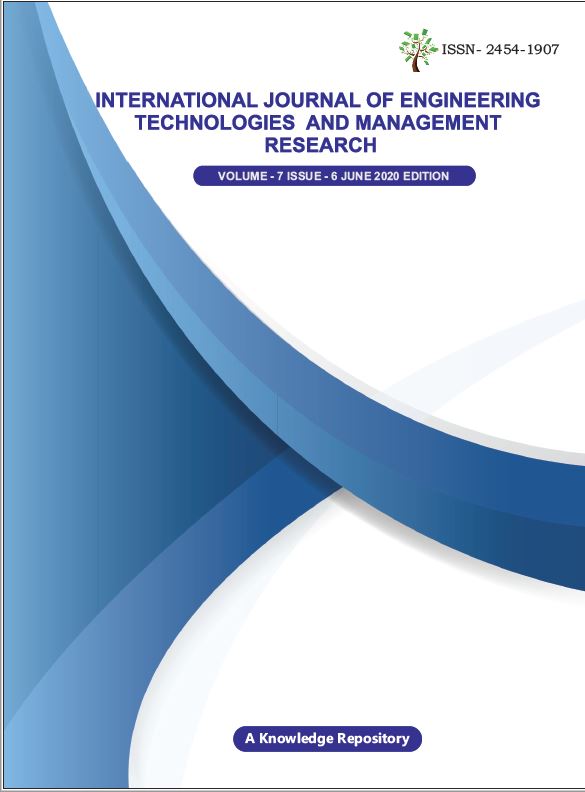REMEDIATION ABILITY OF MELON GRASS IN A CRUDE OIL POLLUTED SOIL IN A TROPICAL REGION
DOI:
https://doi.org/10.29121/ijetmr.v7.i6.2020.527Keywords:
Phytoremediation, Melon Grass, Crude oil Polluted Soil, Physic-Chemical, Heavy MetalsAbstract
The aim of this research was to study the effectiveness of a chosen grass (plant) in the remediation of soil contaminated by crude oil. Lemon grass was used in this study to remediate the polluted soil because of its perceived ability to do so. Five wooden boxes were fabricated, and 150kg of soil were introduced to each of them. Four of the boxes were contaminated with different concentrations of crude oil, while two out of these four boxes were amended with cow dung. One of the boxes that served as control was neither contaminated nor amended. Lemon seeds were then planted in all the boxes and allowed to grow for the period of 12 weeks. Analysis were done at the beginning, during and after the plant growth in order to determine the rate of remediation, with particular interest in the TPH (total petroleum hydrocarbon), and few other heavy metals; copper, magnesium, aluminum. Two concentrations of contamination were artificially made (75g and 150g). The TPH, Pb, Zn and Ni contents of the 75g crude oil contaminated soil were 6.784µg/g, 0.485mg/kg, 0.867mg/kg and 0.030mg/kg respectively. It reduced to 6.356µg/g, 0.058mg/kg, 0.560mg/kg and 0.043mg/kg respectively after remediation. The TPHPb, Zn and Nicontents of the 150g crude oil contaminated soil were 9.109µg/g, 0.699mg/kg, 0.851mg/kg and 0.032mg/kg respectively. It reduced 7.713µg/g, 0.059mg/kg, 0.506mg/kg and 0.057mg/kg respectively after remediation. An interesting observation was that, amending the contaminated soil with cow dung gave a favourable result in remediating the contaminants. It took about 80months to remediate TPH to an acceptable level of 0.013µg/g, but over 150months to do the same for an unamended soil. This finding can be applicable in the estimation of time requirement for the remediation of crude oil polluted soil by concerned stake holders.
Downloads
References
Abioye, P.O., Abdul-Aziz A. & Agamuthu, P. (2009). Enhanced biodegradation of used engine oil in soil amended with organic wastes. Water Air Soil Poll., 209 (1): (173-179).
Agarry, S.E. &Lukuman, J.A. (2013). Application of Carbon-Nitrogen Supplementation from Plant and Animal Sources in In-situSoil Bioremediation of Diesel Oil: Experimental Analysis and Kinetic Modeling; Journal of Environment and Earth Science; Vol. 3, No.7.
Agarry, S.E., Aremu, M.O. &Aworanti O.A. (2013). Kinetic modelling and half- life study on enhanced soil bioremediation of bonny light crude oil amended with crop andanimal-derived organic waste. J Pet Environ Biotechnol 4: 137.
Ana, O.E. (2000). Remediation potential of petroleum refinery waste contaminated land at AlesaEleme, Rivers State. M.Eng Thesis: University of Port Harcourt.
Aronson, D., Boethling, R. & Howard P. (2000). Estimating biodegradation half-lives for use in chemical screening. Chemosphere.63: 1953-1960.
Ayotamuno, M.J., Kogbara R.B.&Probert S.D. (2005). Bioremediation of a crude oil polluted agricultural soil at Port-Harcourt, Nigeria. School of Engineering Cranfield University, Bedfordshire, UK.
Choronn, M. (2010). Bioremedition of crude oil pollutted soil by the application of fertilizers. Iran J Environ Health SciEng 7:319-326.
Cunningham, C.J. & Philip, J.C. (2000). Comparison of Biostimulation in ex-situ Treatment of Diesel Contaminated Soil,
Dadrasania, B.N. (2013). The potential use of biowaste (potato skin, soy cake, cow dung) to remediate a diesel fuel contamianated soil, Science Publishers Inc. pp.34-39.
Ebere, J.U., Wokoma, E.C., Wokocha, C.C. (2011). Enhanced remediation of a hydrocarbon polluted soil, Research journal of environment and earth science.
Ijah, J. &Antal, S.P. (2003). The Potential Use of Poultry drop microorganisms for all Spill Remediation. Environ 2389-95.
Ikhajiagbe, B. &Anoliefo, G.O. (2011). Natural attenuation of a 14-month-old waste engine oil polluted soil. J Soil Sci Environ Manage 2: 184-192.
Leahy, J.G. & Crowell, R. R. (1990). Microbial Degradation of Hydrocarbons in theEnvironment. Microbio.Rev. 3, 305.
Liu, P.G., Tsung, C.C., Liang-Ming, W., Chun-Hsuan, K., Po-Tseng, P. & Sheng-Maletic, S. (2009). Degradation kinetics of an aged hydrocarbon contaminated soil. Water Air Soil Poll 202:149-159.
Morel, J.L., Echevarria, G. &Goncharova, N. (Eds.) (2002). Phytoremediation of Metal-Contaminated Soils, IOS Press, Amsterdam, and Springer in conjunction with the NATO Public Diplomacy Division - Springer.
Okieimen, C.O. &Okiemen, F.E. (2005). Bioremediation of crude polluted soil-effect of poultry droppings and natural rubber processing sludge application on biodegradation of petroleum hydrocarbon. Environ Sci.12:1-8.
Okolo, J.C., Amadi, E.N. &Odu,T.I. (2005). Effects of Soil Treatments using animalmanure on Crude Oil contaminated sandy-loam soil. Appl. Ecol. Environ. Res. 47-53.
Onifade, A. K. (2007). Bioremediation of Crude Oil Polluted Soil in the Niger-Delta Area of Nigeria Using Enhanced Natural Attenuation. Res. J. Appal. Sci. 2498-504.
Osoka, E.C.&Onyelucheya,O.E. (2011). Data-Driven Model for Palm Bunch Ash-Enhanced Bioremediation of a crude oil contaminated soil, 362-363.
Oyoh, K.B &Osoka, E.C. (2002). Rate Model for Bioremediation Based on Total Petroleum Hydrocarbon Content, Journal of Nigerian Society of Chemical Engineers, 22 (2007),50-56.
Parales, R.E., Bruce, C.N., Schmid, A. &Wackett, L. P. (2003). Biodegradation, biotransformation, and biocatalysis (B3). Applied and Environmental Microbiology, 68(10), 4699–4709. DOI: https://doi.org/10.1128/AEM.68.10.4699-4709.2002
Vidali, M. (2001). Bioremediation: An overview. J. Appl. Chemistry, 73(7), 1163–1172. DOI: https://doi.org/10.1351/pac200173071163
Zahed, M.A. (2011). Kinetic modeling and half-life study on bioremediation of crude oil dispersed by corexit 9500. J Hazard Mater 185:1027-1031.
Published
How to Cite
Issue
Section
License
License and Copyright Agreement
In submitting the manuscript to the journal, the authors certify that:
- They are authorized by their co-authors to enter into these arrangements.
- The work described has not been formally published before, except in the form of an abstract or as part of a published lecture, review, thesis, or overlay journal.
- That it is not under consideration for publication elsewhere.
- That its release has been approved by all the author(s) and by the responsible authorities – tacitly or explicitly – of the institutes where the work has been carried out.
- They secure the right to reproduce any material that has already been published or copyrighted elsewhere.
- They agree to the following license and copyright agreement.
Copyright
Authors who publish with International Journal of Engineering Technologies and Management Research agree to the following terms:
- Authors retain copyright and grant the journal right of first publication with the work simultaneously licensed under a Creative Commons Attribution License (CC BY-SA 4.0) that allows others to share the work with an acknowledgment of the work's authorship and initial publication in this journal.
- Authors can enter into separate, additional contractual arrangements for the non-exclusive distribution of the journal's published version of the work (e.g., post it to an institutional repository or edit it in a book), with an acknowledgment of its initial publication in this journal.
- Authors are permitted and encouraged to post their work online (e.g., in institutional repositories or on their website) before and during the submission process, as it can lead to productive exchanges, as well as earlier and greater citation of published work.
For More info, please visit CopyRight Section





















